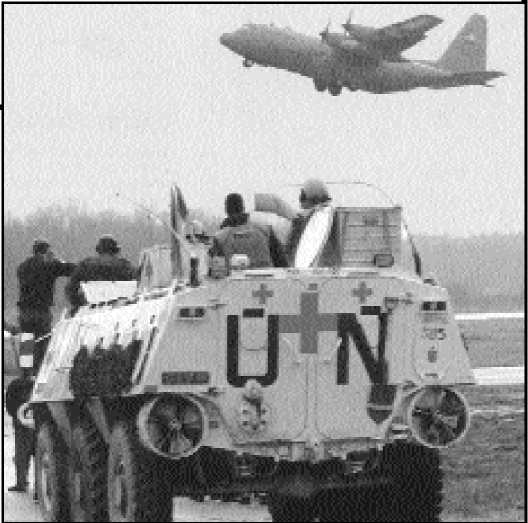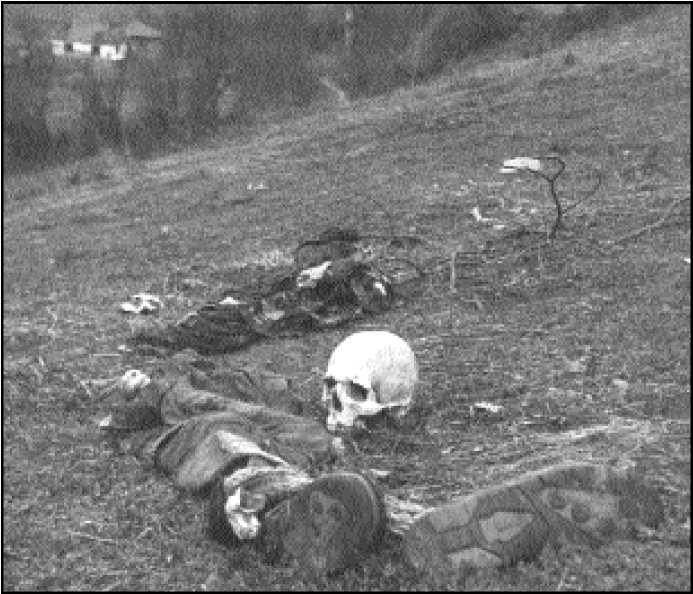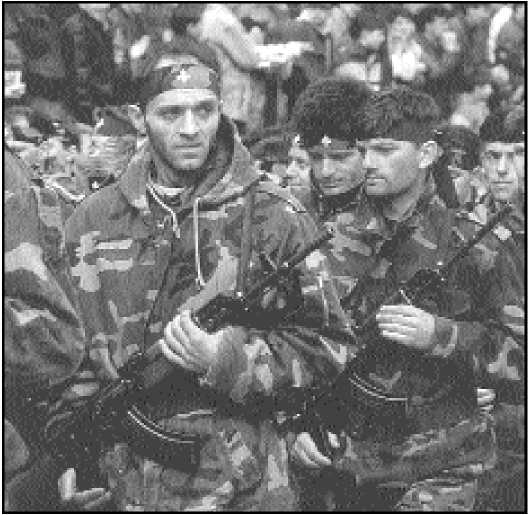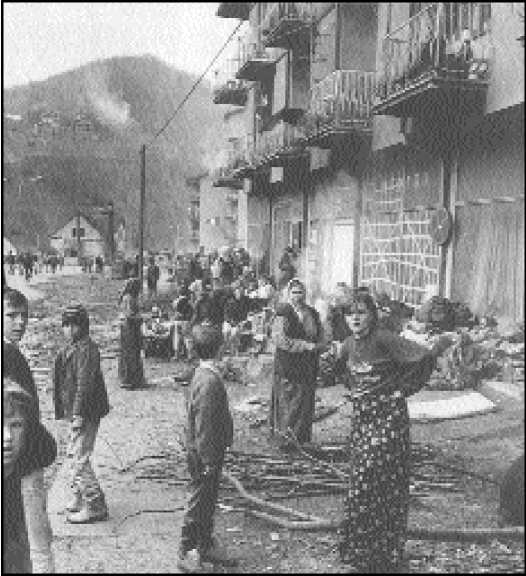
Paul D’Amato Archive | ETOL Main Page
Origins of the War
From International Socialist Review, Issue 7, Spring 1999, pp. 12–15.
Downloaded with thanks from the ISR Archive Website.
Marked up by Einde O’ Callaghan for the Encyclopaedia of Trotskyism On-Line (ETOL).
BETWEEN 1992 and 1995, war raged in Bosnia-Herzegovina (BiH) between nationalist militias and armies of the three dominant ethnic groups – Muslims, Serbs and Croats. In a country half the size of Virginia, almost two million people were driven from their homes and tens of thousands we re killed. The press and politicians portrayed U.S. and NATO intervention then much as they do today: as a way to save the Bosnian Muslims from ethnic cleansing, and to stop rampant Serbian butchery. The course and outcome of that war are therefore instructive in demonstrating the difference between the rhetoric and the reality – and the treacherous role the Western powers played in that tragic fiasco.
Encouraged by the U.S. and Germany, Bosnia-Herzegovina’s Assembly declared its independence in October 1991 – against the wishes of the Serbian delegates, who walked out. Parties based purely on national affiliation had by then been created and, in the heat of the approaching armed conflict, had risen to prominence among each ethnic group – Serbian (34 percent of the population), Muslim (43 percent), and Croatian (17 percent). When a referendum was held in March 1992 on BiH independence, a third of the population, the majority of the Serb population in BiH, refused to participate.

|
The final factor provoking war [in BiH] was the international community’s approach to recognition. Once Croatia and Slovenia had been granted international recognition, [Muslim president of the Bosnian republic] Izetbegovic had no option but to seek the same, as to remain in a Yugoslavia dominated by Milosevic and Belgrade would have been simply unacceptable to all Muslims and Croats in BiH. Izetbegovic was thus forced by German-led EC policy into the same mistake that Tudjman had made voluntarily – he embarked upon secession from Yugoslavia without securing prior agreement from the Serbs. [7]
The U.S. quickly jumped in to support Bosnian independence, without any regard for the fact that a third of the population rejected it. It did so not to prevent violence, but to regain the initiative after resisting Germany’s efforts to recognize Croatia. In doing so, the U.S. helped give the green light for war within Bosnia. The cynicism of U.S. actions became clear when then-President George Bush refused to recognize independence for Macedonia in deference to Greece, which opposed it.
More than any other territory in the former Yugoslavia, BiH did not parcel neatly into different ethnic groups. While it is true that Serbs dominated in the countryside and Muslims in the cities, many towns and villages contained a mixture of two or more ethnic groups, sharing the same culture and language, and often joining in mixed marriages and friendships. The carve-up of BiH implied from the start the “cleansing” of ethnic groups from different areas.
The U.S. and other Western media consistently portrayed the Serbs as purely responsible for the fighting. Serbs were consistently demonized as the only side engaging in ethnic cleansing in Bosnia. The Muslims (and to a lesser extent Croats) were portrayed as victims. This was in part backed up by the propaganda of Izetbegovic and the Muslim nationalist leaders themselves, who put forward the idea that, unlike the Serbs and Croats, they were fighting to retain a multi-ethnic Bosnian state.
There is no doubt that Serbian paramilitaries – armed by Milosevic and aided by the Yugoslav National Army (JNA ) – took the initiative, engaging in horrible atrocities in order to drive Muslims from their homes. Serbian paramilitary militias, under the leadership of the notorious Arkan and the Serbian fascist leader Seselj, committed the worst and most numerous atrocities. Moreover, Muslims, though the largest ethnic group, felt the most vulnerable because – unlike Serbs and Croats – they had no “sponsor” state to back them in the fighting. The imbalance was changed later in the war, when the U.S. began to secretly arm and train Bosnian Muslim fighters. But even before that, the gap between rhetoric and reality was widening, as reports came back from the field that Muslim and Croat forces we re also engaging in ethnic cleansing in parts of BiH.

Remains of victims of Serb atrocities in Bosnia |
The London Guardian reporter Ed Vulliamy – one of the first to report the existence of Serb “concentration camps” where thousands of Muslim men were being held, tortured and randomly executed – also reported detention camps run by Croatian forces. He was also the first to report that over 75,000 Serbs were “ethnically cleansed” from the town of Mostar in Western Herzegovina in 1992 by the Croatian army (HVA), the Croatian fascist militia (HOS) and Muslim paramilitaries, all of which were supplied with German weapons.
The Serbo-Croat partition of Bosnia forced Muslim leaders, in spite of their rhetoric, to create a Muslim state in Bosnia. As the weaker force, they demanded UN and U.S. intervention on their side, and that they be armed. In addition, they continually formed alliances of convenience with Croat forces – in some cases, Croat fascists – to fight the Serbs, in spite of the fact that Croatia’s war aims were to take over half of Bosnia and annex it.
The war sharpened ethnic divisions throughout the entire population, in many cases forcing even mixed families to take sides. But there were sporadic rejections of this barbaric logic. The Croatian and Muslim communities of Fojnica demanded in 1993 that the UN declare the town a peace zone since they refused to fight in the war. The district president, Mijat Tuka, said, “The danger is that the BiH (mainly Muslim army) and the HVO will have plans for Fojnica.” A week later the town was shelled by the Muslim militia. In the mixed town of Tesanj in central Bosnia the people refused to allow the HVO or the BiH to control their militia and declared that they would defend their town against all sides. Though crushed by all sides, gestures like these reflected a vague feeling among a significant minority that no side really represented their interests.
As in Croatia, Western intervention only served to intensify the conflict. Every proposal for a peace accord provoked accelerated military activity, as each side attempted to improve the “facts on the ground” in its own favor. By the first “peace” conference in Lisbon in March 1992, it was accepted by all parties involve d that the “solution” to the crisis in BiH would be some kind of cantonization of the country into three distinct ethnic enclaves. But the very aims of each side in the war were to determine in its own favor the exact nature of that division.
Fearing it might be sucked into a quagmire, yet needing to demonstrate its “leadership” in the crisis, the U.S. was reluctant to commit troops to the region. Instead, the U.S. proposed air strikes on Serbian targets in BiH and the creation of UN-supervised “safe havens” for besieged Muslims. European powers which had already committed troops to the region criticized this policy, fearing that bombing might expose their own forces to attack. The contradiction for the imperialist powers was this: they feared that any escalation could involve them in a quagmire from which they could not extricate themselves. On the other hand, the longer the war went on, the more pressure there was for the U.S., in particular, to prove its ability to police the world. Not to intervene would jeopardize the position of the U.S. as the world’s dominant superpower and undermine the U.S. military alliance in Europe (NATO). That is why then-Secretary of State Warren Christopher called Bosnia “the problem from hell.” For this reason, U.S. military intervention, however halting, became more and more likely as the crisis continued.
Every other permutation of the Bosnian peace plan had the same effect – to encourage further ethnic cleansing. The Vance-Owen plan in 1992 proposed that BiH be divided into 10 ethnic enclaves. That plan was scuttled by the U.S., which criticized it for giving too much to the Serbs. The Vance-Owen plan had allotted eight districts that had an overall majority of Muslims to the Croats. After the plan collapsed, Croatian forces decided to settle Vance-Owen on the ground through a military offensive to drive the Muslims from those areas. In response, the Muslims decided to lay claim to the same areas. After suffering some defeats and terrible atrocities, the Muslims struck back and, in similar fashion, inflicted terrible atrocities to drive Croats out.
Arming the Muslims was not a way to ensure the survival of BiH as a multi-ethnic state, but a means for Muslim nationalists to carve a larger piece of Bosnia, using the same military tactics as their adversaries – mass expulsions and atrocities. If there was any doubt, the fighting in central Bosnia showed this clearly.
The Balkans correspondent Misha Glenny reported

Bosnian government soldiers |
Wherever they could, the Muslims used the considerable sympathy which they enjoyed in the outside world as a cover to undertake military operations. In December and early January [1993], they launched an intensive offensive from Srebrenica with the aim of regaining control of Bratunac, to the east on the river Drina. The Serbs were caught unawares by the attack and the Muslims moved swiftly through Serbian villages, slaughtering a large number of civilians on the way. Because the atrocities we re being perpetrated by the Muslims, they received relatively little attention in the world media. They also provoked a fearsome counter-attack by the Serbs who had soon driven the Muslims back to Srebrenica. Politicians and journalists we re quick to condemn the Serbs for this operation but they entirely neglected to point out that it had been provoked by the original Muslim offensive. [8]
The same pattern was also clear in 1993, when Muslim and Croat forces battled for control of central Bosnia, each side engaging in vicious ethnic cleansing. Again Glenny reported on the three-way insanity of the conflict:
When Gornji Vakuf was being contested, a fight between Croats and Muslims was being monitored by a nearby Serb unit. After some hours, the Muslim guns fell silent. The Serb commander radioed his Muslim counterpart. ‘Why have you stopped firing?’ he asked. ‘We’ve run out of ammunition. Give us some ammunition,’ the reply came. Instead, the Serb commander requested the Croat coordinates which the Muslim commander duly supplied. Over the next four hours, the Serb unit pounded the Croats into surrender. The following morning at dawn, the Muslim commander ordered his men to run up the Yugoslav flag instead of the Bosnian ensign in order to thank the Serbs. [9]
In the same area, Croat forces massacred hundreds of Muslim civilians in the town of Ahmici. After shelling the town to force the townspeople to flee, they sprayed them with machine guns set up across an open field through which the people were forced to run .
In order to give the appearance of decisive action without actually making any costly commitments, the UN – under U.S. pressure – imposed debilitating economic sanctions on Serbia and Montenegro. By demonizing all Serbs for the war in Bosnia, the UN only strengthened the hold of the most rabid Serbian nationalists in the region.
The relief efforts mounted by the UN in Bosnia – in addition to providing a cover for introducing thousands of troops (called the UN Protection Force, or UNPROFOR) – we re sustained primarily to ensure that Europe would not be burdened with the arrival of thousands of refugees from the war-torn region. Likewise, the creation of so-called “safe havens” – regions ostensibly created to protect Bosnian Muslims from attack – was motivated by the desire to ensure that the victims of ethnic cleansing stayed in Bosnia. The reality is that these areas were proven to be far from safe. When these “safe havens” in places like Srebrenica and Goradze were finally overrun by Serbian forces, UN “peacekeepers” stood by and allowed it to happen.
As one historian writes,
An additional tactic of warfare was thus encouraged. The Bosnian government turned the safe areas into bases for rest, recuperation and resupply of troops within “enemy” territory that it hoped to regain and for bases from which to fire out of their enclave into Serb-claimed territory. The aim of the latter was to provoke Serbian artillery fire to invoke the use of air power against the Serbs and to use the media attention and test of UN and NATO credibility that safe areas would attract ... to reinforce their propaganda strategy of getting the victims of Serb aggression and deserving of military support. [10]
In reality, the “humanitarian intervention” on the part of U.S., UN and NATO in BiH had nothing to do with saving the lives of the war’s victims. Ironically, the same governments which claimed to be intervening on behalf of the beleaguered refugees were the same countries whose financial policies in the former Yugoslavia – under the auspices of the IMF – had demanded austerity measures that included increased unemployment, welfare cuts and other market “medicine” against the people of the region in the 1980s.
In 1993 the U.S. was finally able to strong-arm its reluctant European war partners into adopting a new policy – NATO air strikes against the Bosnian Serbs, combined with arming the Bosnian Muslim army. The policy was called “lift and strike.”
|
The same governments which claimed to be intervening on behalf of the beleaguered refugees were the same countries whose financial policies in the former Yugoslavia – under the auspices of the IMF – had demanded austerity measures that included increased unemployment, welfare cuts and other market “medicine.” |

Muslim refugees in Srebrenica, 1993 |
Peter Galbraith, U.S. ambassador to Croatia, brokered a new alliance – after the two sides had been fighting for months in central Bosnia – between Croatia and the Bosnian Muslims. To “level the playing field” further, a group of retired U.S. generals helped Croatia to devise a military plan, with U.S. and German military aid, to overrun the Serb-held Krajina. It was this three-pronged offensive – Croat invasion of Krajina, Muslim attack in central Bosnia and punishing air strikes – that finally brought all sides to the negotiating table in 1995 to sign the Dayton Accords.
The U.S. proved in practice that it had no problem at all with ethnic cleansing, or even the planning of ethnic cleansing, when it suits its own interests. What was ominously dubbed “Operation Storm” drove upwards of 200,000 Krajina Serbs from their homes in the largest single act of ethnic cleansing of the entire Bosnia war. Human rights observers reported burning of homes, looting and massacres of elderly Serbs too old to flee the region. In a matter of days, Serbs were ethnically cleansed from whole swaths of Croatia and Bosnia, against which Milosevic lifted not a finger. Clinton praised Operation Storm, saying that he was “hopeful Croatia’s offensive will turn out to be something that will give us an avenue to a quick diplomatic solution.” [11]
Two weeks of intensive NATO bombing, combined with the arming of Bosnian Muslim forces, decisively shifted the balance of forces in favor of the Muslim side in the war. As a result, the Croat and Bosnian government offensive took 1,600 square miles of territory and expelled over 60,000 Serbs from their homes. By the time the Accords were signed, the biggest beneficiary in the war turned out to be Croatia. By the fighting’s end, Serbs we re the largest group of refugees in the former Yugoslavia.
Though the Dayton Accords called for a nominally unitary Bosnian state, in practice they merely put the signature on what the war had already accomplished: the carve-up of Bosnia between the nationalists into ethnically pure enclaves, ruled over as a UN protectorate. The agreement created two statelets: one Serb, the other Croat-Muslim. Sarajevo – the city that stood the longest against ethnic division and hatred, decreed by Dayton an “undivided city” – was divided into nine ethnic zones. The Croat-Muslim alliance began to unravel before the ink was dry on the Accords. Tudjman made it clear that he saw the alliance as one of convenience, which would be tolerated only in order to get U.S. weapons and support. But Croatia had other plans for Bosnia – to annex half of it.
Although the Accords called for the right of refugees to return home, the reality is that refugees were cynically used to populate areas controlled by their own nationalist leaders, regardless of where they lived before. With only a day’s notice, for example, the Bosnian government shipped hundreds of Muslim refugees in October 1995 from Zenica into the town of Kljuc. Forty percent of the refugees we re not returnees, but lived elsewhere in Bosnia before they were driven out. The refugees were forced to find shelter in a bombed-out town with no food or water. In the town of Jacje, Croat forces sealed off the town and only allowed Croats to return. Thousands have – refugees forced to leave Croatia – but several busloads of Muslims were turned back. In Banja Luka, likewise, Serbs were busily kicking out the remaining Muslims and Croats who still lived in areas under Serb control.
Several years later, Bosnia remains a tense region, policed as a UN protectorate, whose appointed officers have control overall major economic and military decisions. In effect, the area remains under permanent U.S./NATO/UN military occupation, whose mission is to police the bloody borders its own policies have helped to create. The local economy remains mired in economic crisis, unable to attract investment or create jobs. In each enclave, nationalist rulers – many of them hated for the havoc they have wrought – remain in power, backed by Western guns. This is not a “solution” to Bosnia’s crisis. It merely paves the way for future wars, as each side catches its breath and reloads.
In Bosnia, U.S. and European intervention has only fueled the madness and strengthened the region’s nationalist bullies. The only solution to the barbarism in Bosnia is the one workers throughout the former Yugoslavia began to pursue more than a decade ago: class struggle, which unites workers across ethnic lines. That means rejecting the priorities of the region’s rulers and rejecting national chauvinism – while fighting for a democratic, multi-ethnic regional federation. Here in the U.S., the solution to the crisis in the Balkans must begin with demanding that the U.S., the world’s biggest bully, keep its hands off the region. Imperialist bombs are never “humanitarian.”
7. Glenny, p. 151.
8. Glenny, p. 221.
9. Glenny, p. 231.
10. Woodward, pp. 320–321.
11. Quoted in Jason Vest, Clinton Bombs Again, Village Voice, April 7–13, 1999.
Paul D’Amato Archive | ETOL Main Page
Last updated: 24 August 2021